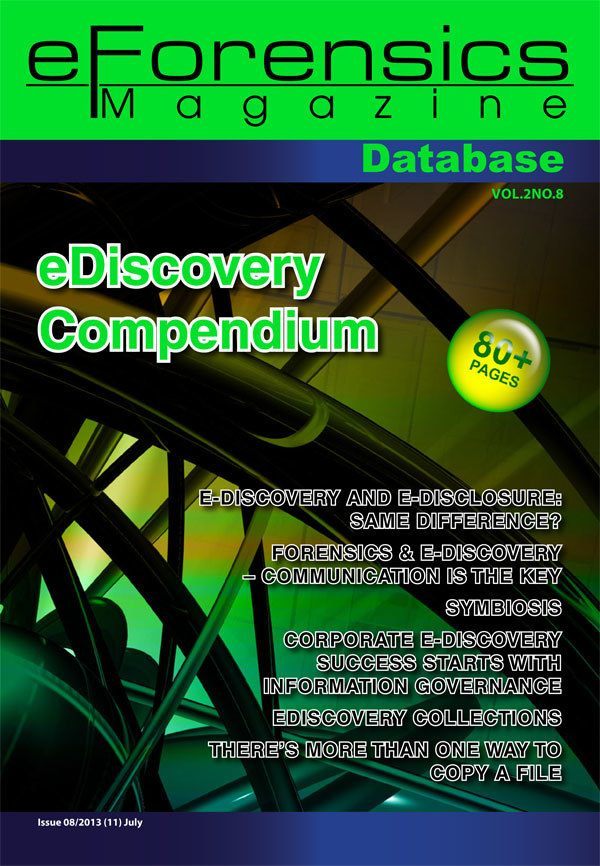
| File | |
|---|---|
| eForensics_08_2013_NEW.pdf |
eForensics Readers!
Our team would like to introduce you the latest issue of eForensics Database series.
Find the table of contents below:
E-DISCOVERY AND E-DISCLOSURE: SAME DIFFERENCE?
by Jerome Raguin
In the United Kingdom (UK) the generally accepted term is E-Disclosure. In the US it is typically referred to as E-Discovery. Is it just a linguistic variation of the same discipline or do the two terms really reflect a difference in concepts or reality? Are they two sides of the same coins or do these two terms reflect substantial differences?
FORENSICS & E-DISCOVERY – COMMUNICATION IS THE KEY
by Mark Surguy
This article unpicks the multiple facets of E-Discovery and explores how the computer forensics skill-set can make a big difference. The technologies available will only ever do the job if the right people are working together in the right way.
FORENSICS IN THE LAW: NAVIGATING ESI, EDISCOVERY AND RECORDS MANAGEMENT
by Kelly Twigger
As a forensics professional, you are hip-deep in data every day. You know where to find it, how to filter it, and odds are, you could have any set of data make you a fine Sunday brunch. Your prowess with data makes you indispensable to attorneys, especially since the majority of information is created electronically these days.
THERE CAN BE NO JUSTICE WITHOUT TRUTH, AND NO TRUTH WITHOUT SEARCH
by Ralph C. Losey
Justice is based on truth, on what really happened. That is a basic problem in law because facts are usually contested. Each side has their own story. The truth is out there, but requires search to discover. Truth and justice thus depend upon effective search.
SYMBIOSIS
by Robert F. Bradley
The presentation, maintenance and storage of data are the core functions of both. Three simple, easily implemented solutions; opening lines of communication, enhancing knowledge and cooperative planning, will better facilitate teamwork vital to the success of the overall enterprise.
CORPORATE E-DISCOVERY SUCCESS STARTS
by Alice E. Burns
E-discovery is one of many critical components of information governance. A well-executed information governance program is the method successful organizations are starting to use to effectively address data growth and e-discovery concerns.
PREDICTIVE CODING BASED LEGAL METHODS FOR SEARCH AND REVIEW
by Ralph C. Losey
Predictive coding type algorithms are designed to leverage the expertise of human input, preferably attorneys who are subject matter experts of the case at hand. A classification of one document by an attorney results in a recommended classification of hundreds, if not thousands of other documents that the computer identifies as similar.
CHANGING RISKS IN EDISCOVERY
by Kevin Faulkner
There have always been risks and pitfalls in the eDiscovery process. Significant steps have been taken in recent years to address some of these risks, such as the development of systems to index data on an enterprise wide level rather than on a project-to-project basis using ad-hoc tools. But are the same steps now creating new risks that have yet to be addressed?
EDISCOVERY: CRIMINAL PROCESS IN A CORPORATE WORLD
by Adam Hughes
Following the rise of eDiscovery over recent years, companies recognise the need to be able to find and produce data for a range of business needs from internal tribunals to regulatory requirements. More recently, high profile incidents, breaches and leaks have highlighted the need for companies to investigate in a legal framework that can open eDiscovery processes and tools to court scrutiny. What can be done today if tomorrow is unknown….
EDISCOVERY COLLECTIONS
by Brett Shavers
Electronically Stored Information (ESI) collection sounds easy but it is fraught with landmines and hazards. More than just knowing how to copy files, the ESI specialist needs to be part of the planning process and be an expert in electronic data and data systems in order to be effective. This article addresses many of these aspects of ESI collection.
TRUTH VERIFICATION TECHNIQUES & CHARACTER PROFILING
by Clifton Coetzee
While there are many high quality software systems available to detect and prevent cyber fraud, dealing face to face with the humans that perpetrate these frauds requires different skill sets. Intelligent, but sadly sociopathic humans design and develop IT systems to perpetrate cyber frauds. Sometimes we never get to meet these individuals because they are shielded by layers of anonymity. They could be anywhere; in their own homes or in shopping malls where they can access (with or without authority) a decent wifi connection.
THE INTERVIEW WITH PETER W. MCCANN, FOUNDER OF E3 DISCOVERY CONSULTANTS
by Vaman Amarjeet
THE INTERVIEW WITH JARED COSEGLIA, FOUNDER AND PRESIDENT OF TRU STAFFING PARTNERS
by Ivan Sabo
EDISCOVERY DOCUMENT REVIEW TRENDS
by Cynthia Marple
Review of collected Electronically Stored Information (“ESI”) to determine relevancy, confidentiality level and privilege is a time consuming process. In addition, some projects require reviewers to analyze each document for the possible application of up to fifty or more issue codes as well as determining relevancy, confidentiality level and privilege.
HOW TO TAKE CONTROL OF YOUR DATA
by Benjamin Marks and Brent Stanley
Poor quality data might not be searchable but that must not diminish its relevance or the need to understand its content. Whereas predictive coding employs technology that relies upon the search ability of good quality text, what is your workflow for the boxes of paper and the unsearchable electronic files created from third generation scans?
| File | |
|---|---|
| eForensics_08_2013_NEW.pdf |